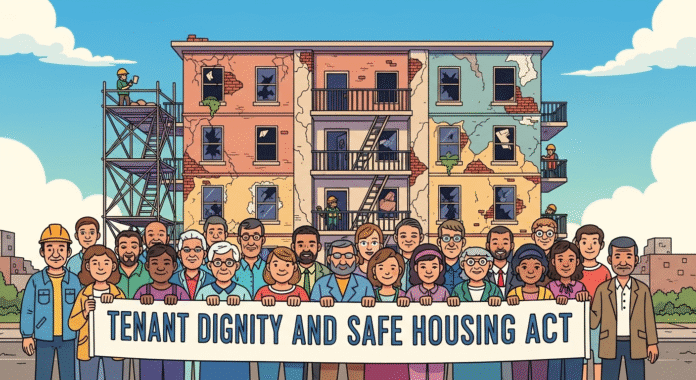How new tenant protections are reshaping renter rights in Syracuse and why additional safeguards remain essential.
The Tenant Dignity and Safe Housing Act is transforming the relationship between renters and landlords in Syracuse. By allowing tenants to sue for repairs and habitability issues, the law tackles unsafe living conditions head-on while giving tenants the confidence to stand up for their rights. Yet, even as more repairs are ordered and evictions fall, many in the community question if the Act alone can resolve a housing crisis marked by unsafe conditions, limited options, and fears of landlord retaliation.
Understanding the Tenant Dignity and Safe Housing Act
The Tenant Dignity and Safe Housing Act, effective since December 2023, offers Syracuse tenants a legal pathway to seek redress against landlords who fail to maintain habitable homes. This law is designed to empower renters by letting them file lawsuits against landlords for code violations, ask for rent reductions, or receive financial compensation when their homes fall below acceptable standards.
Under this Act, tenants can file “7D petitions” in City Court—a legal process that compels landlords to address issues ranging from sewage backups and vermin infestations to inadequate heating and cooling. Template forms, detailed guidelines, and accepted documentation (such as photos, code reports, and repair receipts) simplify the process for tenants who might otherwise be overwhelmed by legal complexities.
Judge Shadia Tadros, who regularly hears these cases, has instituted measures that allow tenants to remain in their apartments while repairs are being made. This critical provision removes the immediate threat of eviction and pushes landlords to comply with repair orders.
Impact on Syracuse Renters
The new law is shifting the balance of power in Syracuse’s rental market. Tenants now have legal backing when confronting dire housing conditions, a change that has already yielded notable improvements in the community.
Tangible Improvements Through 7D Petitions
Since the Act’s enactment, Syracuse City Court has seen a surge in 7D petitions. Housing advocates report a 35% increase in filings, with many cases targeting landlords known for repeated code violations. As a result, there has been a 20% jump in landlord compliance in fixing longstanding issues. Tysha Martin, director of community engagement at CNY Fair Housing, explained, “This is the first tool that I’ve had to use that actually levels the playing field.”
The process typically follows these steps:
- Tenants document the hazardous conditions in their rental units.
- They fill out a petition form detailing issues, monthly rent, and the remedy they seek.
- Filed evidence, including photos and code violation reports, supports the petition.
- Judges review the case and can halt eviction filings while ordering necessary repairs.
Such procedures ensure that tenants do not have to resort to withholding rent or enduring dangerous conditions in silence. The Act not only helps repair properties but also builds tenant confidence in pursuing their rights.
Reduction in Evictions and Increased Security
One notable achievement of the Tenant Dignity and Safe Housing Act has been a marked drop in eviction rates. Data from housing advocates indicates a 15% reduction in evictions since the law’s passage. By legally protecting tenants from retaliatory actions—such as non-renewal of leases or unjust eviction notices—the Act contributes to lessening the cycle of displacement experienced by low-income renters.
Sal Curran, executive director of the Volunteer Lawyers Project, commented, “We’ve seen repairs being made even in cases with multiple code violations. However, it is not fast enough for many tenants who fear reprisal.”
Challenges and Concerns
Despite significant progress, the Act faces several challenges that could impede its full potential in addressing Syracuse’s housing woes.
Fear, Retaliation, and Tenant Hesitation
A primary concern voiced by many housing advocates is the fear of landlord retaliation. Tenants often hesitate to file a petition when they worry that their actions might prompt landlords to retaliate—either by choosing not to renew a lease or by initiating eviction proceedings under alternative pretenses. Sal Curran explained, “Tenants are afraid to file a petition because they’re afraid that there’ll be repercussions by the landlord.” This sense of vulnerability keeps some renters from leveraging the legal protections available to them.
Legal and Administrative Hurdles
Court backlogs present another obstacle. The rapid increase in 7D petitions means that local housing courts are now facing longer wait times for hearings. Assemblymember Bill Magnarelli observed that “local code enforcement departments can take a great deal of time to pursue bad actors.” Such delays undermine the prompt resolution of disputes, leaving tenants in limbo while dangerous living conditions persist.
Additionally, the Act does not entirely shield tenants from the persistent risks of retaliatory evictions. Although there are measures designed to protect renters, the law currently places the burden on tenants to prove discrimination or retaliation—an often challenging and expensive legal battle.
Comparing Syracuse with Other New York Cities
Across New York State, cities have taken varied approaches to tenant protection. While Syracuse relies on the Tenant Dignity Act and its associated 7D petitions, other cities like Albany, Ithaca, and Poughkeepsie have supplemented tenant protections with “Good Cause Eviction” ordinances.
Good Cause Eviction Ordinances: A Complementary Model?
“Good Cause” eviction laws prevent landlords from ending tenancies without a legitimate reason, thus reducing the scope for arbitrary or retaliatory evictions. In Albany, for example, these ordinances have contributed to a 25% drop in eviction filings—a rate notably higher than Syracuse’s 15% reduction. Housing experts argue that by pairing the Tenant Dignity Act with robust Good Cause protections, Syracuse could further safeguard its rental community.
However, not everyone agrees on this approach. Assemblymember Magnarelli has argued against a direct adoption of Good Cause ordinances, asserting that amendments to address retaliation within the existing framework might be more effective and less disruptive. “I don’t think you have to jump to the other thing,” he stated, cautioning that limiting rent increases too stringently might deter new housing investment—a sentiment that resonates with those who believe that more housing units must be built to tackle the crisis.
Proposed Solutions and Future Directions
Advocates agree that while the Tenant Dignity and Safe Housing Act marks a critical step forward, further measures are essential for a comprehensive solution.
Increasing Funding and Enforcement
Housing advocates call for increased funding to boost code enforcement efforts in Syracuse. More inspectors and quicker response times would ensure that once a petition is filed, corrective actions are implemented without unnecessary delay. Enhancing enforcement mechanisms would also deter landlords from repeatedly ignoring repair orders.
Expanding Tenant Support and Awareness
Organizations such as the Syracuse Tenants Union are working tirelessly to educate renters about their rights. Proposals include establishing a Tenant Support Unit within the city government that would guide tenants through the legal process and connect them with necessary resources. Educational campaigns in marginalized communities could also empower more residents to speak up against unsafe living conditions.
Revisiting Eviction Protections
To complement the Act, many advocates are pushing for stronger protections against retaliatory evictions. By adopting measures similar to Good Cause Eviction ordinances—or amending the current law to include clearer guidelines—Syracuse could create a more secure environment for its tenants. “Good cause would make 7D petitions even stronger,” noted Sal Curran, highlighting the need for a multifaceted approach to tenant safety.
Building Affordable Housing
Finally, the long-term solution to Syracuse’s housing challenges may be the construction of thousands of new, affordable housing units. Assemblymember Magnarelli stressed that while legal reforms are crucial, they must be accompanied by robust investment in housing stock. Without a significant increase in available, habitable homes, even the best tenant protections can only do so much.
Steps Toward a Fairer Housing Future
The Tenant Dignity and Safe Housing Act is already changing the landscape of Syracuse’s rental market. It empowers tenants to hold landlords accountable, resulting in critical repairs and a reduction in evictions. Yet, challenges remain—from fears of retaliation and legal delays to a broader shortage of safe, affordable housing.
As Syracuse continues to navigate these complex issues, coordinated efforts involving increased funding for enforcement, expanded tenant education, stronger legal protections, and the construction of affordable housing are essential. The Act is a powerful tool, but it is only one part of a necessary, broader strategy to ensure that every renter can access a safe, dignified home.
If you or someone you know has experienced unsafe rental conditions, share your story and learn more about your rights. Get involved with local tenants’ organizations and help shape a future where every home is a safe haven.




